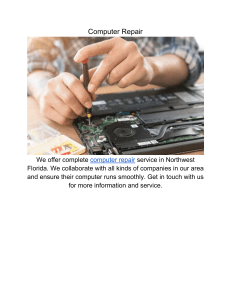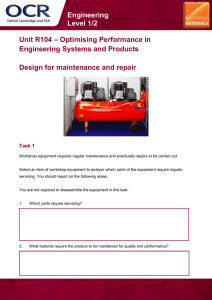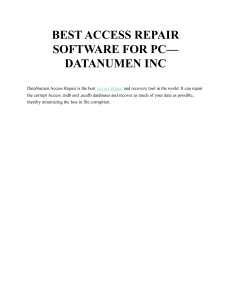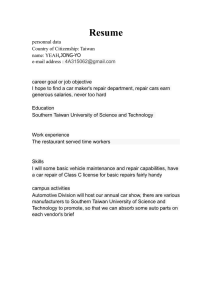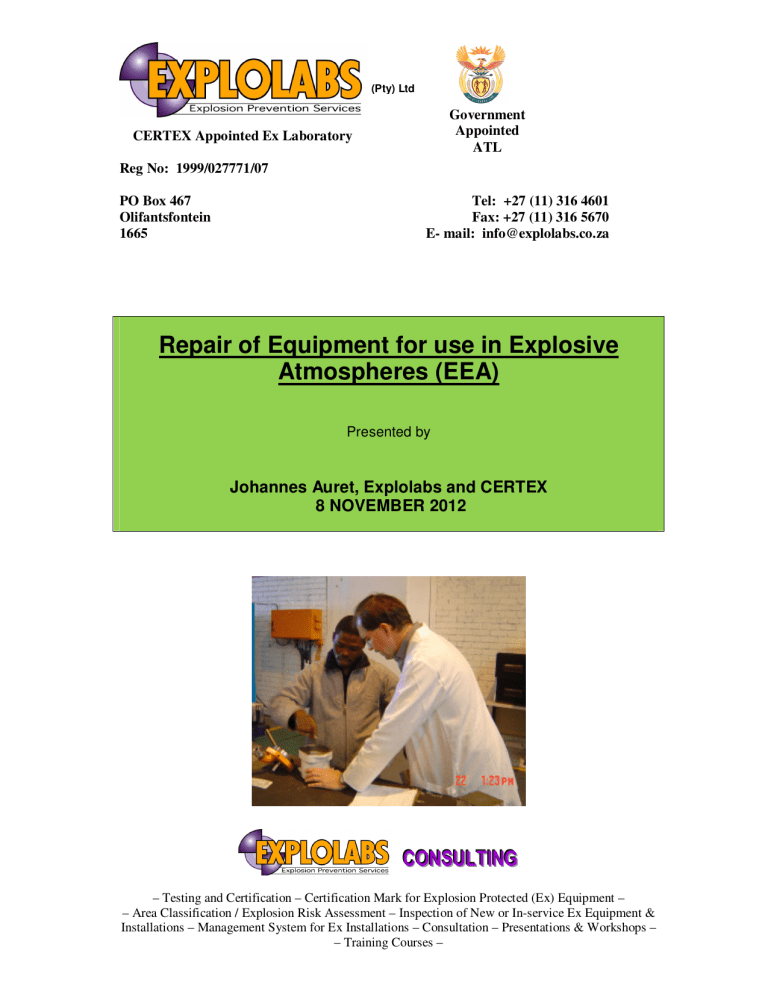
(Pty) Ltd Government Appointed ATL CERTEX Appointed Ex Laboratory Reg No: 1999/027771/07 PO Box 467 Olifantsfontein 1665 Tel: +27 (11) 316 4601 Fax: +27 (11) 316 5670 E- mail: info@explolabs.co.za Repair of Equipment for use in Explosive Atmospheres (EEA) Presented by Johannes Auret, Explolabs and CERTEX 8 NOVEMBER 2012 CO ONNSUULLTTING G – Testing and Certification – Certification Mark for Explosion Protected (Ex) Equipment – – Area Classification / Explosion Risk Assessment – Inspection of New or In-service Ex Equipment & Installations – Management System for Ex Installations – Consultation – Presentations & Workshops – – Training Courses – Repair of Equipment for use in Explosive Atmospheres Page 2 of 13 EXECUTIVE SUMMARY The repair of Equipment for use in Explosive Atmospheres (EEA) is based on the principle of Back to Norm. This may be achieved by the manufacturer or a repairer, provided the right method is followed. The choice of the edition of a standard to use for repair is a grey area; the various options are discussed and best practice is presented. The application of SANS 10086-3 is discussed, and also the implications of the brand-new ARP 0108 Edition 2 for normal repairs, conversion of non-EEA and EEA with outdated certification. INDEX TOPICS Page 1. Introduction to Equipment for use in Explosive Atmospheres........................................... 3 Part 1 – The cause of explosions 3 Part 2 – How one prevents an explosion using EEA 3 2. Repairable EEA ............................................................................................................... 4 3. The repair of EEA ............................................................................................................ 8 3.1 Repair principles 8 3.2 Original Equipment Manufacturers (OEMs) 10 3.3 Non-OEM repairs 10 3.4 Which standards to use for repair 10 3.5 Which edition of a standard should be used for repair 11 3.6 Allowed repair techniques and good practice 11 3.7 Quality control tools 12 3.8 Conversion of standard equipment to Ex nA or Ex t 12 4. Conclusions ................................................................................................................... 12 This material belongs to CCO ONNSSUULLTTIINNG G Repair of Equipment for use in Explosive Atmospheres Page 3 of 13 1. Introduction to Equipment for use in Explosive Atmospheres Such equipment is also known as Explosion-protected Apparatus (EPA), Ex Equipment. In this paper we create a new name namely EEA. What is the importance of Equipment for use in Explosive Atmospheres (EEA)? The answer comes in two parts: Part 1 – The cause of explosions An explosion may occur when an explosive mixture of flammable gas or dust in air (called an explosive atmosphere) is exposed to an ignition source (a spark, arc or hot surface) with sufficient energy to ignite the mixture. If the rate of combustion and volume of the explosive atmosphere is sufficient, a shock wave is produced that may be capable of causing huge damage. Because three elements have to be present, i.e. fuel (a flammable gas, vapour or dust), oxygen (from air), and an ignition source, an explosion can be illustrated by a triangle (known as the combustion triangle). Flammable material Oxygen (air) elel Ignition source Part 2 – How one prevents an explosion using EEA The saying “prevention is better than cure” is 100% apt. To prevent an explosion, one of the three elements must be removed (prevented from being present). a) Remove flammable material Unplanned sources of release (leaks in joints and pump seals) can be minimized by good maintenance. Another example is flammable gas monitoring as part of a hot work procedure. b) Remove oxygen (air) In this approach, the flammable material is not exposed to atmospheric oxygen, by containment in a closed, pressurized system (e.g. pumping of a flammable fluid). This material belongs to CCO ONNSSUULLTTIINNG G Repair of Equipment for use in Explosive Atmospheres Page 4 of 13 Strategies a) and b) are the primary strategies and form part of the design considerations of any plant handling flammable materials. However, explosive atmospheres will still occur as a necessary part of normal operational conditions (e.g. storage tank vents, process vents, sampling points, drains, sumps) or as a result of equipment failures that are covered by operational procedures (e.g. leaking of pump seals and pipe flanged joints). For these situations, ignition sources have to be removed. c) Remove ignition sources EPA may be used, as such equipment will prevent ignition of explosive atmospheres. Precautions against build-up of static charge is another example. Clearly, EEA makes an important contribution to explosion prevention. A fair amount of EPA undergoes repairs, that must not affect the safety of the equipment. This paper deals with the optimization of the repair process. 2. Repairable EEA This material belongs to CCO ONNSSUULLTTIINNG G Repair of Equipment for use in Explosive Atmospheres Page 5 of 13 For various reasons, not all EEA is suitable for repair, including: - Damage caused by stripping; - Cost of repair versus cost of replacement. The table below gives more information about typical equipment to which EEA techniques are commonly applied. Equipment potentially suitable for economic repairs is underlined. NOTE that the term “repair” as used in the Ex standards refer to both “reclamation” repairs requiring removal or replacement of material to restore damaged components and “replacement” repairs, the latter requiring only exchange of faulty components for compliant ones. Ex Protection Equipment Type Ex d (Flameproof) Schematic Representation Control panels Switchgear including Transformers Motors Light Fittings Instruments Solenoids Connectors e.g. cable glands This material belongs to CCO ONNSSUULLTTIINNG G Repair of Equipment for use in Explosive Atmospheres Page 6 of 13 Ex Protection Equipment Type Ex e (Increased safety) Terminal boxes Light fittings Motors Solenoids Transformers Connectors e.g. cable glands Ex i, Ex iD (Intrinsic Safety) Instruments Control devices Solenoids Other electronics This material belongs to Schematic Representation R L C CCO ONNSSUULLTTIINNG G Repair of Equipment for use in Explosive Atmospheres Page 7 of 13 Ex Protection Equipment Type Ex p, Ex pD (Pressurisation) Control panels Gas analysers Control and MCC Rooms MV and HV Motors Ex m, Ex mD (Encapsulation) Solenoids Relays Fuses Indicator (LED) lights Through-bushes Gear Trays for Lights Ex q (Sand-filling or powder-filling) Capacitors Transformers Ex nA (Non-sparking) Terminal boxes Light fittings Motors Transformers Solenoids This material belongs to Schematic Representation CCO ONNSSUULLTTIINNG G Repair of Equipment for use in Explosive Atmospheres Page 8 of 13 Ex Protection Equipment Type Ex tD (previously DIP) Schematic Representation Terminal boxes Switchgear Light fittings Motors Solenoids 3. The repair of EEA 3.1 Repair principles Principle 1 for EEA is that an already certified product is brought back to original specification. This ensures that the existing certification remains valid (more practically, that the EEA remains safe). Principle 2 deals with necessary modifications. Should a modification be required, recertification will also be required, unless the modification does not affect the explosion protection. This principle is imbedded in ARP 0108 as follows: Should a product be modified or changed in such a way that it no longer complies with the certified design, it shall be re-submitted to an ATL for re-evaluation. This re-evaluation shall take into account the current national standard and the product shall comply with that standard. This applies to newly manufactured as well as second-hand products. Modifications affecting the flameproofing of Ex d equipment include: - Enclosure modifications such as changes to or addition of flameproof joints, changes in shape, dimension, or material, changing a motor from foot-mounted to flangemounted configuration; and Modifications to the electrical circuitry that influence temperature or pressure profiles or electrical fault protection. This material belongs to CCO ONNSSUULLTTIINNG G Repair of Equipment for use in Explosive Atmospheres Page 9 of 13 Modifications affecting non-sparking (Ex nA) motors include: - Fitting a non-certified terminal block; and Replace an antistatic plastic fan with a non-antistatic fan or replacing a metal fan with a plastic fan. A relevant example of an essential modification was when the mining industry converted from collectively screened to individually screened trailing cables. Principle 3 deals with availability of equipment information required for repairs. requirements are stated as follows: The SANS 60079-0 (in Clause 30) Al new EEA must be supplied together with instructions for safety, i.e. – putting into service; – use; – assembling and dismantling; – maintenance, overhaul and repair; – installation; and – adjustment. SANS 60079-19 (in a note to the Introduction) Whilst some manufacturers recommend that certain equipment be returned to them for repair there are also competent independent repair organizations who have the facilities to carry out repair work on equipment employing some or all of the types of protection covered by SANS 60079. For repaired equipment to retain the integrity of the type(s) of protection employed in its design and construction, detailed knowledge of the original manufacturer’s design (which may only be obtainable from design and manufacturing drawings) and any certification documentation may be necessary. Where equipment is not being returned to the original manufacturer for repair, the use of repair organisations that are recommended by the original manufacturer should be considered. SANS 60079-19 (in Clause 4) In circumstances where the certification documents are not available, then the repair or overhaul shall be carried out on the equipment in accordance with this standard (SANS 60079-19) and other relevant standard(s). ARP 0108 Repairs and overhauls carried out by a party other than the certificate holder, where the repairer or overhauler is not in possession of the certification documents, shall be carried out in such a manner that the product meets the requirements of the applicable national standards to which the product was originally certified, or any more recent edition. This material belongs to CCO ONNSSUULLTTIINNG G Repair of Equipment for use in Explosive Atmospheres Page 10 of 13 3.2 Original Equipment Manufacturers (OEMs) The design drawings are used for repairs by some OEMs. Sometimes these drawings do not provide for minimum repair requirements, for example reduced flange thicknesses compared to as-manufactured equipment. In such cases, the same approach as given for non-OEM repairs may be followed. 3.3 Non-OEM repairs There are two possibilities: a) Repair information is available (provided by the OEM to the user and further to the repairer) in accordance with SANS 60079-0 requiring that all new EEA must be supplied together with instructions for safety, i.e. – putting into service; – use; – assembling and dismantling; – maintenance, overhaul and repair; – installation; and – adjustment. In SA, all parties involved are still, in the author’s opinion, too slack in applying this requirement. Overseas, some certifiers actually review the contents of these documents. National consensus on how to apply this requirement should be sought. b) Repair information is not available. In this author’s opinion, the two critical rules in this case are (a) that the equipment to be repaired must be certified EEA and (b) that minimum safety requirements of the relevant design standard(s) listed above must be met. Proof that the repaired unit has been type tested and certified should of course be provided in the form of an IA certificate. Unfortunately certification records are not always available. In such a case, proof of certification is normally provided by the compulsory marking on the equipment. If labels are missing or illegible, a unit under repair can as a last resort, be crosschecked against an identical unit of which the certification status can be verified. A typical example of minimum design safety requirements is the maximum gap allowed on flameproof joints. The equipment must be clearly described. The new draft ARP 0108 requires that, when repairing existing equipment without an IA certificate under a product certification scheme, a repairer has to draw up a specification from his database for each type of equipment. This should be extended to all repairs. 3.4 Which standards to use for repair ■ EEA repair standard Covers best repair practice. This material belongs to CCO ONNSSUULLTTIINNG G Repair of Equipment for use in Explosive Atmospheres Page 11 of 13 Currently SANS 10086-3 Ed. 2: 2011, The installation, inspection and maintenance of equipment used in explosive atmospheres Part 3: Repair and overhaul of equipment. NOTE – SANS 10086-3 incorporates SANS 60079-19: Ed. 3: 2011, Explosive atmospheres Part 19: Equipment repair, overhaul and reclamation. ■ Design standard For minimum design requirements for non-OEM repairs. ■ Installation standard For plugs and (when present) connectors. Question: Should an Ex plug be provided? ■ Specialized equipment repair standards National repair standards may override/complement SANS 10086-3 in certain industries, e.g. SANS 1561-1 and SANS 10242-1 for LV induction motors. A decision should be made on national level what the status of such a specialized repair standard must be, as there could be significant cost implications. 3.5 Which edition of a standard should be used for repair Standards are dynamic in that they are regularly upgraded to stay abreast of technological development and improved safety concepts. This issue needs attention, as many repairers do not clearly identify and implement a certain edition of standards relevant for repairs. For instance, a repair checklist will only state the number of a standard, or a certain edition of a standard will be quoted but on closer scrutiny the requirements stated will not correspond to the edition. Again, a single national ruling will be ideal. A suggestion is to use either the latest or the 2ndlatest edition of a standard. Two issues affect this choice: a) A repairer must upgrade his repair system every time a new edition of a standard is selected by him, for instance skills, equipment and quality documents. b) The rules or guidelines provided by regulators. For instance, DMR requires that the editions quoted in the regulations of the Mine Health and Safety Act must be used. DOL appears to accept the recommendation included with the reference standards in all IEC-based standards i.e. to use the latest edition of a standard. 3.6 Allowed repair techniques and good practice The way in which information on repair practice is provided in SANS 10086-3 (SANS 6007919) is illustrated below. Mechanical Example 1: Flameproof Enclosures FLANGED JOINTS Technique: Use welding or electroplating in combination with re-machining, but do not use metal spraying. Good practice: Welding should not cause distortion and/or weakening of the component. This material belongs to CCO ONNSSUULLTTIINNG G Repair of Equipment for use in Explosive Atmospheres Page 12 of 13 Electrical Example 1: Flameproof Equipment ISOLATOR Technique: Replace electrical part of isolator with identically rated unit of another make. Good practice: Should be placed in the same position, with adequate clearances and creepage distances, and of nominally the same size. 3.7 Quality control tools The use of a suitable checklist that also acts as a record sheet is strongly recommended. It has been mentioned that the new draft ARP 0108 will introduce the requirement that, when operating under a product certification scheme, a repairer must draw up a checklist for each type of equipment and an ATL must approve the checklist. Although this requirement focuses on the certification of equipment without an IA certificate, it can be strongly recommended for all equipment being repaired. The checklist shall be supported by a detailed product description. The description shall include sketches, photos, drawings or combinations of these, to identify the equipment and define its essential Ex properties. 3.8 Conversion of standard equipment to Ex nA or Ex t This practice is exercised mainly on motors by repairers and involves selecting a motor that meets the basic requirements (new motor: SANS 1804/IEC 60034-1 type design, restriction of magnesium in light alloy fans and cowls, mechanical strength of enclosure, minimum air gap, wedged windings) and applying approved conversion methods (terminals, sealing of terminal box, fan and cover, determine temperature class) to such a motor. This practice has initially been carried out under accepted mark schemes and did not require further certification. A new requirement, to be introduced in the draft ARP 0108, is that prototype converted motor must be submitted to a test laboratory (ATL) for type (once-off) testing and certification. This will officially terminate the old practice. 4. Conclusions Although SA’s Ex repair industry is one of the oldest and most successful in the world, it does not always earn the desired confidence from equipment owners. An improvement agenda may include the following: ● Phase in IA certification for all EEA including equipment taken out of service for repairs. ● Use approved repair checklists. ● Draw up an equipment specification showing essential Ex information. Can be combined with the above checklist. ● Clarify which standards and editions of such standards are to be used for repairs. ● Equipment users must ensure that they obtain repair information from OEMs and This material belongs to CCO ONNSSUULLTTIINNG G Repair of Equipment for use in Explosive Atmospheres Page 13 of 13 distribute this information to repairers when repair is required. It must further be agreed which repair information can reasonably be expected. For example, an assembly drawing of Ex d equipment showing flameproof joint details ? Mark scheme operators should communicate these issues to their repair companies. We hope that this paper provides a guideline for management of EEA repairs. This material belongs to CCO ONNSSUULLTTIINNG G
